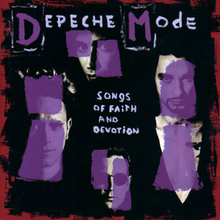Songs of Faith and Devotion
| Songs of Faith and Devotion | ||||
|---|---|---|---|---|
 |
||||
| Studio album by Depeche Mode | ||||
| Released | 22 March 1993 | |||
| Recorded | February 1992 – January 1993 | |||
| Studio | Chateau du Pape (Hamburg); Madrid | |||
| Length | 47:26 | |||
| Label | Mute | |||
| Producer | Depeche Mode, Flood | |||
| Depeche Mode chronology | ||||
|
||||
| Singles from Songs of Faith and Devotion | ||||
|
||||
| Professional ratings | |
|---|---|
| Review scores | |
| Source | Rating |
| AllMusic | |
| Chicago Sun-Times | |
| Entertainment Weekly | B |
| NME | 8/10 |
| Q | |
| Rolling Stone | |
| The Rolling Stone Album Guide | |
| Select | 4/5 |
Songs of Faith and Devotion is the eighth studio album by English electronic music band Depeche Mode, released in the United Kingdom on 22 March 1993 by Mute Records and in the United States and Canada on 23 March by Sire and Reprise Records. The album incorporated a more aggressive, darker rock-oriented tone than its predecessor, Violator (1990), largely influenced by the emerging alternative rock and grunge scenes in the United States.
Upon its release, Songs of Faith and Devotion reached number one in several countries, and became the first Depeche Mode album to debut atop the charts in both the UK and the US. To support the album, Depeche Mode embarked on the fourteen-month-long Devotional Tour, the largest tour the band had ever undertaken to that date.
Recording the album and the subsequent tour exacerbated growing tensions and difficulties within the band, prompting Alan Wilder to quit, making this album the final with him as a band member. The ordeal had exhausted their creative output following the enormous success they had enjoyed with Violator, leading to rumours and media speculation that the band would split. Depeche Mode subsequently recovered from the experience, and released Ultra in 1997.
Songs of Faith and Devotion was recorded over eight months in a rented villa in Madrid during 1992, as well as later sessions in Hamburg and London. Following his work on U2's seventh studio album, Achtung Baby, producer Flood suggested the idea of building their own studio in a rented house where the band would live and work, the same process having yielded huge successes for U2. A studio was set up in the basement of the villa, with two drum kits using different spaces to achieve different sounds. The recordings from the kits could then be processed through synthesizers, such as the large Roland System 700 the band had installed in the studio. The band had become aware of getting caught in easy routines in the studio leading to boredom and thus wanted to change as many aspects to their approach to the recording as possible.
...
Wikipedia
